Toyota 4Runner: Rear view monitor system (rear view mirror-attached type)
The rear view monitor assists the driver by displaying an image of the area behind the vehicle while reversing. The image is displayed in reverse on the screen. This reversed image is a similar image to the one on the inside rear view mirror.
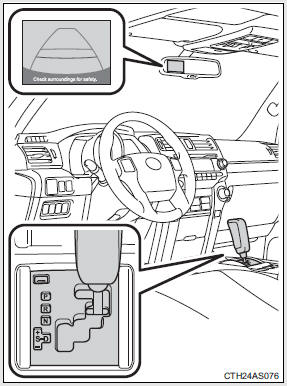
The rear view image is displayed when the shift lever is in R.
• If the shift lever is shifted out of R, the screen is turned off.
• The screen remains on for approximately 5 minutes.
Rear view monitor guide lines

Guide lines are displayed on the screen.
The guide lines may look different depending on vehicle orientation or road conditions.
1. Vehicle width extension guide lines (blue) These lines indicate the estimated vehicle width extension.
2. Distance guide line (blue) This line indicates a position on the ground about 3 ft. (1 m) behind on the ground of the rear bumper of your vehicle.
3. Distance guide line (red) This line indicates a position on the ground about 1.5 ft. (0.5 m) behind on the ground of the rear bumper of your vehicle.
4. Vehicle center guide lines (blue) These lines indicate the estimated vehicle center on the ground.
The rear view monitor system can be operated when
Vehicles without a smart key system
The shift lever is in R, the engine switch is in the “ON” position.
Vehicles with a smart key system
The shift lever is in R, the “ENGINE START STOP” switch is in IGNITION ON mode.
Changing display modes
The rear view monitor display mode can be changed while the screen is on.
• To temporarily disable the rear view monitor system
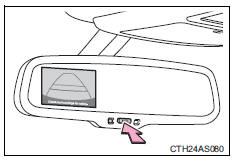
Push the “AUTO” button.
The indicator will turn amber.
Vehicles without a smart key system
The system will be re-enabled once the engine switch is turned OFF and then turned to the “ON” position.
Vehicles with a smart key system
The system will be re-enabled once the “ENGINE START STOP” switch is turned OFF and then turned to IGNITION ON mode.
• To constantly disable the rear view monitor system Push and hold the “AUTO” button for 12 to 15 seconds.
The screen will turn off and on after 6 seconds. Continue to push and hold the button until the screen turns back off. The indicator will flash amber.
Vehicles without a smart key system
The system will not automatically turn on again after the engine switch is turned OFF and then turned to the “ON” position.
Vehicles with a smart key system
The system will not automatically turn on again after the “ENGINE START STOP” switch is turned OFF and then turned to IGNITION ON mode.
• To re-enable the rear view monitor system Push the “AUTO” button. The indicator will turn green.
Selecting a language (English, French or Spanish)

 Push and hold the “AUTO” button
Push and hold the “AUTO” button
for 6 to 12 seconds.
The screen will turn on and the indicator will turn green.
 Push the “AUTO” button.
Push the “AUTO” button.
Each time the “AUTO” switch is pushed, the language changes. Stop pushing the button when the message is displayed in the desired language.
After approximately 5 seconds, the warning message will flash once and the language will be set.
Displayed area
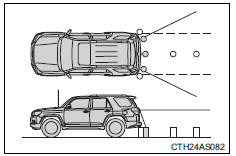
The area covered by the camera is limited.
Objects that are close to either corner of the bumper or under the bumper cannot be seen on the screen.
The area displayed on the screen may vary depending on vehicle orientation or road conditions.


Driving precautions
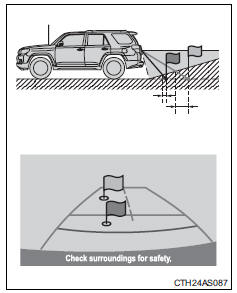
When the grade behind the vehicle slopes up sharply, objects appear to be farther away than they actually are.
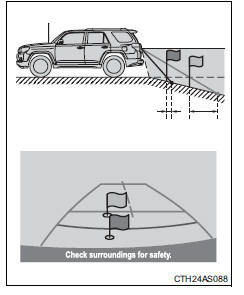
When the grade behind the vehicle slopes down sharply, objects appear to be closer than they actually are.
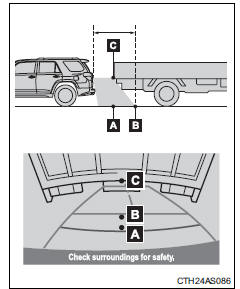
The distance that appears on the screen between three-dimensional objects (such as vehicles) and flat surfaces (such as the road) and the actual distance differ as follows.
In reality, C = A < B (C and A are equally far away; B is farther than C and A). However, on the screen, the situation appears to be A < B < C.
On the screen, it appears that a truck is parking about 1.5 ft. (0.5 m) away. However, in reality if you back up to point A, you will hit the truck.
Rear view monitor system camera
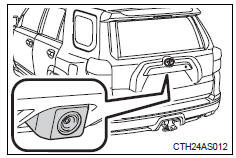
The rear view monitor system camera is located on the back door as shown in the illustration. The camera uses a special lens. The distance of the image that appears on the screen differs from the actual distance.
In the following cases, it may become difficult to see images on the screen even when the system is functioning correctly:
• The vehicle is in a dark area, such as at night.
• The temperature near the lens is extremely high or low.
• Water droplets are on the camera lens or humidity is high, such as when it rains.
• Foreign matter, such as snow or mud, adheres to the camera lens.
• When the camera has scratches or dirt on it.
• The sun or headlights are shining directly into the camera lens.
• A bright object such as a white wall is reflected in the mirror surface over the monitor.
Smear effect

If a bright light, such as sunlight reflected off the vehicle body, is picked up by the camera, a smear effect* characteristic to the camera may occur.
*: Smear effect -- A phenomenon that occurs when a bright light is picked up by the camera; when transmitted by the camera, the light source appears to have a vertical streak above and below it.
Flicker effect
When the camera is used under fluorescent light, sodium lights, or mercury lights etc., the lights and the illuminated areas may appear to flicker.
CAUTION
When using the rear view monitor system
Observe the following precautions to avoid an accident that could result in death or serious injuries:
• Never depend solely on the monitor system when reversing.
• Always check visually and with the mirrors to confirm your intended path is clear.
• Use your own eyes to confirm the vehicle’s surroundings, as the displayed
image may become faint or dark, and moving images will be distorted, or not
entirely visible when the outside temperature is low. When backing up, be sure
to check behind and all around the vehicle visually and with the mirrors before
proceeding.
• Always check the vehicle surrounding area, because the guide lines are
ancillary lines.
• The guide lines are ancillary lines and do not change even if the steering wheel is turned.
• Depicted distances between objects and flat surfaces differ from actual distances.
• Do not use the system if the back door is open.
Conditions which may affect the rear view monitor system
• If the back of the vehicle has been hit, the camera’s position and mounting angle may have changed. Have the vehicle inspected by your Toyota dealer.
• Rapid temperature changes, such as when hot water is poured on the vehicle in
cold weather, may cause the system to function abnormally.
• If the camera lens is dirty, it cannot transmit a clear image. Rinse with water and wipe with a soft cloth. If the camera lens is extremely dirty, wash with a mild cleanser and rinse.
• The displayed image may be darker and moving images may be slightly distorted when the system is cold.
Caution while driving in reverse
Do not change modes while the vehicle is moving.
NOTICE
Camera precautions
• As the camera has a water proof construction, do not detach, disassemble or modify it. This may cause incorrect operation.
• Do not subject the camera to a strong impact.
• If the camera lens becomes dirty, it cannot transmit a clear image. If water droplets, snow, or mud adhere to the lens, rinse with water and wipe with a soft cloth. If the lens is extremely dirty, wash it with a mild cleanser and rinse. Do not rub hard.
• Do not allow organic solvent, car wax, window cleaner or glass coat to adhere to the camera. If this happens, wipe it off as soon as possible.
• When replacing tires, please consult your Toyota dealer. If you replace the tires, the area displayed on the screen may change.
 Detection range of the sensors
Detection range of the sensors
1. Approximately 1.6 ft. (50 cm) 2. Approximately 4.9 ft. (150 cm)
The diagram shows the detection range of the sensors. Note that the sensors
cannot detect obstacles that are extremely close to ...
 Four-wheel drive system (part-time 4WD models)
Four-wheel drive system (part-time 4WD models)
Use the front-wheel drive control lever or switch to select the following
transfer modes:
Type A
The four-wheel drive indicator comes on when H4, N or L4 mode is selected.
1. H2 (high speed pos ...
Other materials about Toyota 4Runner:
Pressure Control Solenoid "A" Electrical (Shift Solenoid Valve SL1) (P0748)
DESCRIPTION
Shifting from 1st to 5th is performed in combination with the ON and OFF operation
of the shift solenoid valves SL1, SL2, S1, S2 and SR, which are controlled by the
ECM. If an open or short circuit occurs in one of the shift solenoid valves, t ...
Acn Call End
ACN CALL END
1. ACN CALL END
This function terminates the ACN (Automatic Collision Notification) to the telematics
provider. After a collision in which the DCM receives a "Collision Detection Signal",
the vehicle will send the emergency call no ...
